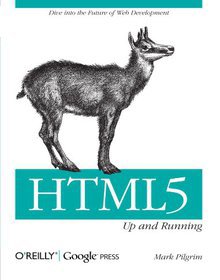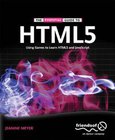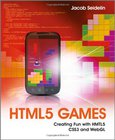HTML5
Up and Running

Book Details:
| Publisher: | O'Reilly Media |
| Series: | OReilly , Up and Running |
| Author: | Mark Pilgrim |
| Edition: | 1 |
| ISBN-10: | 0596806027 |
| ISBN-13: | 9780596806026 |
| Pages: | 222 |
| Published: | Aug 24 2010 |
| Posted: | Nov 19 2014 |
| Language: | English |
| Book format: | |
| Book size: | 5.56 MB |
Book Description:
If you don't know about the new features available in HTML5, now's the time to find out. The latest version of this markup language is going to significantly change the way you develop web applications, and this book provides your first real look at HTML5's new elements and attributes. Even though work on HTML5 is ongoing, browsers such as Safari, Mozilla, Opera, and Chrome already support many of its features -- and browsers for smart phones are even farther ahead, especially iPhone's MobileSafari browser. With HTML5: Up Running, you'll learn how this new version enables browsers to interact with JavaScript much more easily than before. You'll also learn how HTML5 can help you develop applications that: Display video directly in the browser, without having to rely on plugins Work even when a user is offline, by taking advantage of HTML5's persistent storage Offer a drawing canvas for dynamically generated 2-D graphics This concise guide is the most complete and authoritative book you'll find on the subject. Author Mark Pilgrim writes the weekly digest for the HTML5 Working Group, and represents Google at conferences on HTML5's capabilities. Stay ahead of the curve. Order a copy of this book today. Five Things You Should Know About HTML5 by Mark Pilgrim 1. Its not one big thing. You may well ask: How can I start using HTML5 if older browsers dont support it? But the question itself is misleading. HTML5 is not one big thing; it is a collection of individual features. So you cant detect HTML5 support, because that doesnt make any sense. But you can detect support for individual features, like canvas, video, or geolocation. You may think of HTML as tags and angle brackets. Thats an important part of it, but its not the whole story. The HTML5 specification also defines how those angle brackets interact with JavaScript, through the Document Object Model (DOM). HTML5 doesnt just define video tag; there is also a corresponding DOM API for video objects in the DOM. You can use this API to detect support for different video formats, play a video, pause, mute audio, track how much of the video has been downloaded, and everything else you need to build a rich user experience around the video tag itself. Chapter 2 and Appendix A will teach you how to properly detect support for each new HTML5 feature. 2. You dont need to throw anything away. Love it or hate it, you cant deny that HTML 4 is the most successful markup format ever. HTML5 builds on that success. You dont need to throw away your existing markup. You dont need to relearn things you already know. If your web application worked yesterday in HTML 4, it will still work today in HTML5. Period. Now, if you want to improve your web applications, youve come to the right place. Heres a concrete example: HTML5 supports all the form controls from HTML 4, but it also includes new input controls. Some of these are long-overdue additions like sliders and date pickers; others are more subtle. For example, the email input type looks just like a text box, but mobile browsers will customize their onscreen keyboard to make it easier to type email addresses. Older browsers that dont support the email input type will treat it as a regular text field, and the form still works with no markup changes or scripting hacks. This means you can start improving your web forms today, even if some of your visitors are stuck on IE 6. Read all the gory details about HTML5 forms in Chapter 9. 3. Its easy to get started. Upgrading to HTML5 can be as simple as changing your doctype. The doctype should already be on the first line of every HTML page. Previous versions of HTML defined a lot of doctypes, and choosing the right one could be tricky. In HTML5, there is only one doctype: !DOCTYPE html Upgrading to the HTML5 doctype wont break your existing markup, because all the tags defined in HTML 4 are still supported in HTML5. But it will allow you to use -- and validate -- new semantic elements like article, section, header, and footer. Youll learn all about these new elements in Chapter 3. 4. It already works Whether you want to draw on a canvas, play video, design better forms, or build web applications that work offline, youll find that HTML5 is already well-supported. Firefox, Safari, Chrome, Opera, and mobile browsers already support canvas (Chapter 4), video (Chapter 5), geolocation (Chapter 6), local storage (Chapter 7), and more. Google already supports microdata annotations (Chapter 10). Even Microsoft -- rarely known for blazing the trail of standards support -- will be supporting most HTML5 features in the upcoming Internet Explorer 9. Each chapter of this book includes the all-too-familiar browser compatibility charts. But more importantly, each chapter includes a frank discussion of your options if you need to support older browsers. HTML5 features like geolocation (Chapter 6) and video (Chapter 5) were first provided by browser plugins like Gears or Flash. Other features, like canvas (Chapter 4), can be emulated entirely in JavaScript. This book will teach you how to target the native features of modern browsers, without leaving older browsers behind. 5. Its here to stay. Tim Berners-Lee invented the world wide web in the early 1990s. He later founded the W3C to act as a steward of web standards, which the organization has done for more than 15 years. Here is what the W3C had to say about the future of web standards, in July 2009: Today the Director announces that when the XHTML 2 Working Group charter expires as scheduled at the end of 2009, the charter will not be renewed. By doing so, and by increasing resources in the HTML Working Group, W3C hopes to accelerate the progress of HTML5 and clarify W3Cs position regarding the future of HTML. HTML5 is here to stay. Lets dive in.
Download Link:
Related Books:
HTML5 Solutions
Essential Techniques for HTML5 Developers
HTML5 brings the biggest changes that HTML has seen in years. Web designers and developers now have a whole host of new techniques up their sleeves, from displaying video and audio natively in HTML, tocreating realtime graphics directly on a web page without the need for a plugin. But all of these new technologiesbring more tags to learn and more avenues for things to go wrong. HTML5 Solutions provides a collection of solutions to all of the most common HTML5 problems. Every solution contains sample code that is production-ready and can be applied to any project. What youll learnReal-world solutions for everyday HTML development, saving hours of frustration. Problems covered include: Sending multi-bitrate videos to different devices Creating custo...
The Essential Guide to HTML5
Using Games to learn HTML5 and JavaScript
HTML5 opens up a plethora of new avenues for application and game development on the web. Games can now be created and interacted with directly within HTML, with no need for users to download extra plugins, or for developers to learn new languages. Important new features such as the Canvas tag enable drawing directly onto the web page. The Audio tag allows sounds to be triggered and played from within your HTML code, the WebSockets API facilitatesreal-time communication, and the local storage API enables data such as high scores or game preferences to be kept on a user's computer for retrieval next time they play. All of these features and many more are covered within The Essential Guide to HTML5. The book begins at an introductory level, teaching t...
HTML5 Games
Creating Fun with HTML5, CSS3, and WebGL
Discover new opportunities for building 2D and 3D games with HTML5The newest iteration of HTML, HTML5 can be used with JavaScript, CSS3, and WebGL to create beautiful, unique, engaging games that can be played on the web or mobile devices like the iPad or Android phones. Gone are the days where games were only possible with plugin technologies such as Flash and this cutting-edge book shows you how to utilize the latest open web technologies to create a game from scratch using Canvas, HTML5 Audio, WebGL, and WebSockets. You'll discover how to build a framework on which you will create your HTML5 game. Then each successive chapter covers a new aspect of the game, including user input, sound, multiplayer functionality, 2D and 3D graphics, and more. Aims...
HTML5 Games Most Wanted
Build the Best HTML5 Games
HTML5 Games Most Wantedgathers thetop HTML5 games developers and revealsthe passion they all share for creating and coding great games. You'll learn programming tips, tricks, and optimization techniques alongside real-world code examples that you can use in your own projects. You won't justmake gamesyou'll make great games.The book is packed full of JavaScript, HTML5, WebGL, and CSS3 code, showing you how these fantastic games were built and passing on the skills you'll need to create your own great games. Whether you're a coding expert looking for secrets to push your games further, or a beginner looking for inspiration and a solid game to build on and experiment with, HTML5 Games Most Wanted is for you. Topics and games covered include building com...
2007 - 2021 © eBooks-IT.org




